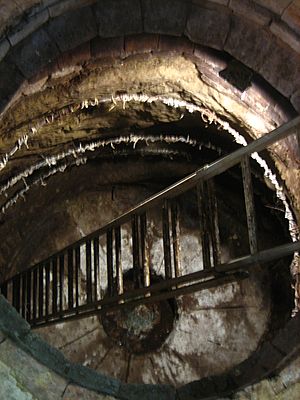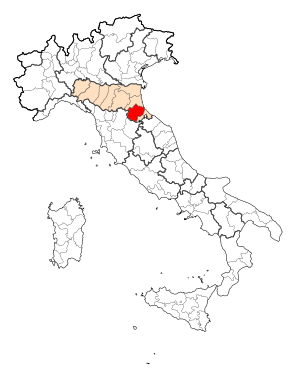Formaggio di Fossa facts for kids
Quick facts for kids Formaggio di Fossa |
|
|---|---|
 |
|
| Country of origin | Italy |
| Region | Emilia-Romagna, Marche |
| Town | Sogliano al Rubicone |
| Source of milk | Cow, sheep, or mix of both |
| Aging time | 30 days prior to being placed in a pit ("fossa"), plus 80–100 days inside the fossa, plus 3 months after removal from the fossa |
| Certification | PDO |
Formaggio di Fossa is a special cheese from Italy. Its name means "cheese of the pit" in Italian. This unique cheese comes from Sogliano al Rubicone in the Emilia-Romagna region. It gets its name because it ripens inside special pits. These pits are dug into soft rock called tuff.
This cheese is made in the valleys between the Rubicon and Marecchia rivers. In 2009, Formaggio di Fossa received a special status. It was named a "Denominazione di Origine Protetta" (DOP). This means it's a protected product from a specific area. It's like saying this cheese can only be made in this special way and place.
How Formaggio di Fossa is Made
Formaggio di Fossa can be made from different kinds of milk. It can be made from sheep's milk, cow's milk, or a mix of both.
First, the cheese ages for about 30 days. After this, it is ready for the "fossa" (pit). These pits are dug deep into the ground. They are often lined with straw. Before the cheese goes in, the pit is prepared. Straw is burned inside to make it dry and clean. This also helps to get rid of any unwanted germs.
Next, the cheese is wrapped carefully in cloth bags. Then, these bags are placed inside the pit. The pit is completely sealed shut. The cheese stays in the pit for a long time, usually 80 to 100 days. Sealing the pit means there is very little air inside. This helps the cheese ripen in a special way. It's called "anaerobic fermentation," which means it ages without much oxygen.
Once the cheese is taken out of the pit, it ages even more. It ripens for another three months. This old way of making Formaggio di Fossa has been around for a very long time. People have been using this pit method since the 15th century!



